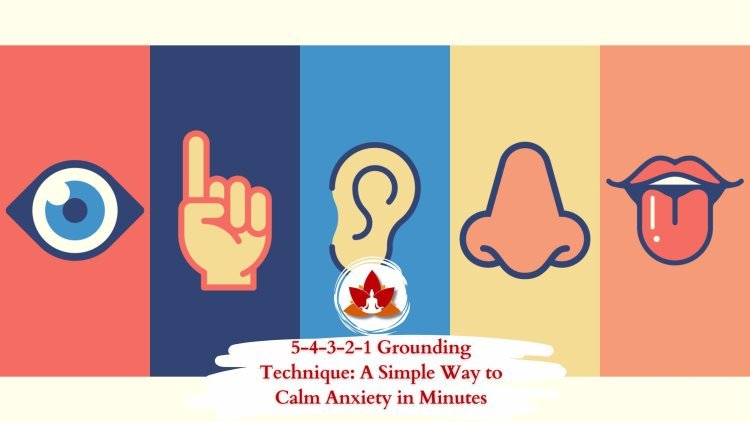5-4-3-2-1 Grounding Technique: A Simple Way to Calm Anxiety in Minutes

Feeling anxious or overwhelmed? The 5-4-3-2-1 grounding technique is a quick and powerful way to bring yourself back to the present moment and calm your mind within minutes.
This simple mindfulness exercise helps you shift your focus away from racing thoughts and anxiety, reconnecting you with what’s real and tangible—the here and now.
“The 5-4-3-2-1 method brings us out of anxiety, unwanted thoughts, or worries and into the present through our senses,” explains Stephanie Strauss, yoga, meditation, and mindfulness specialist.
In this article, we’ll take a closer look at how the 5-4-3-2-1 grounding technique works, how to practice it effectively, and the many benefits it offers. Whether you’re managing an intense wave of anxiety or simply seeking to live more mindfully each day, this tool can help you find peace and stability in the present moment.
Why Are Grounding Techniques So Helpful?
By shifting your focus from troubling thoughts to the present moment, grounding exercises offer instant relief from anxiety and support better mental health.
What Are Grounding Techniques?
Grounding techniques are simple cognitive and emotional practices that help bring your awareness back to the present, easing feelings of nervousness, tension, or dissociation.
When your mind starts to wander or spiral into worry, applying a grounding method helps you reconnect with your body and surroundings. This interrupts the stress response and restores a sense of calm and control.
Types of Grounding Techniques
Grounding can be practiced in several ways, depending on what resonates with you most:
1. Sensory Grounding
These techniques use your five senses—sight, hearing, touch, taste, and smell—to anchor you in the here and now.
A classic example is the 5-4-3-2-1 grounding exercise, which helps you notice your environment in a mindful and structured way.
2. Physical Grounding
Physical grounding brings your attention back to your body through movement or sensation.
Examples include deep breathing, progressive muscle relaxation, or tapping techniques, which help release tension and bring awareness to the present moment.
3. Cognitive Grounding
These techniques engage your mind to redirect attention away from distressing thoughts or emotions.
You can try counting backward, reciting a calming affirmation, or solving a simple puzzle to shift your focus.
4. Environmental Grounding
This approach focuses on creating a safe and soothing space to support emotional stability.
You might listen to a calming playlist, surround yourself with comforting objects, or declutter your space to cultivate peace and relaxation.
The 5-4-3-2-1 Grounding Method: At a Glance
Feeling anxious or overwhelmed? The 5-4-3-2-1 grounding technique is a simple yet powerful tool to bring you back to the present moment. All you need to do is gently notice:
-
5 things you can see
-
4 things you can touch
-
3 things you can hear
-
2 things you can smell
-
1 thing you can taste
This quick and effective mindfulness exercise uses your five senses to anchor you in the here and now, helping you find calm even in moments of chaos or confusion.
Easy to remember and effortless to practice, the 5-4-3-2-1 method is one of the most practical and proven techniques for reducing stress and anxiety — anytime, anywhere.
How to Practice the 5-4-3-2-1 Grounding Technique
If you’d like to try the 5-4-3-2-1 grounding technique, here’s a simple step-by-step guide to bring yourself back to the present moment:
5 | Notice Five Things You Can See
Look around and identify five things within your surroundings. It could be the color of a wall, the texture of a cushion, or a favorite photograph. Observe their details — color, shape, light, and texture.
By focusing on what you see, you shift your attention away from anxious thoughts and back to what’s real and immediate.
4 | Notice Four Things You Can Hear
Gently close your eyes and tune into the sounds around you — perhaps the hum of a fan, distant voices, or birds singing outside.
Becoming aware of these sounds draws your mind outward, away from worries, helping you reconnect with your environment.
3 | Notice Three Things You Can Feel
Turn your awareness to touch. Notice how your clothes feel on your skin, the texture of what you’re holding, or the steady ground beneath your feet.
This simple act helps you reconnect with your body and reestablish a sense of physical presence and safety.
2 | Notice Two Things You Can Smell
Take a slow, deep breath and notice two scents around you — maybe the aroma of coffee, fresh air, or even soap on your hands.
Engaging your sense of smell helps interrupt repetitive thoughts and brings your attention back to the present.
1 | Notice One Thing You Can Taste
Finally, focus on your sense of taste. You might take a sip of water, a bite of food, or simply notice the lingering taste of toothpaste or tea.
This final step completes the grounding process, gently anchoring you in the here and now with calm awareness.
How the 5-4-3-2-1 Grounding Technique Works
The 5-4-3-2-1 grounding technique works by gently guiding your attention back to the present moment through your senses. Here’s how it helps calm both mind and body:
-
Encourages Sensory Awareness
This exercise heightens your awareness of your immediate surroundings. By naming what you can see, touch, hear, smell, and taste, you become actively engaged with your environment, drawing your attention away from anxious thoughts and into the present. -
Engages Neural Pathways
When you mindfully notice and name sensory details, you activate neural pathways responsible for awareness and focused attention. This process helps retrain your brain to stay grounded instead of getting lost in spiraling thoughts. -
Interrupts the Anxiety Loop
According to mindfulness specialist Stephanie Strauss, this practice offers an instant mental reset. By stimulating your senses, it pulls your mind out of the loop of worry and redirects your attention outward — toward the real, tangible world around you. -
Calms the Body
Focusing on your senses can also activate the parasympathetic nervous system, your body’s natural relaxation response. This helps reduce the physical symptoms of anxiety — such as rapid heartbeat or tense muscles — and restores a sense of peace and balance.
Tips for Practicing the 5-4-3-2-1 Grounding Technique
Here are a few helpful tips to make your 5-4-3-2-1 grounding practice more effective and calming:
1. Notice When You Need It
The first step is awareness. Try to recognize when you’re starting to feel overwhelmed, anxious, or panicked. When that happens, pause and take a moment to begin the exercise.
“Building this awareness is often the toughest challenge,” says Stephanie Strauss.
2. Slow Down
Don’t rush through the process. If you can, move through each step slowly and mindfully, allowing yourself to fully experience each sensation. And if you’re short on time, even a partial practice can make a difference.
3. Let Go of Judgment
When observing what you see, hear, smell, feel, or taste, avoid labeling or judging them as pleasant or unpleasant. Simply notice them with curiosity and objectivity — this helps reduce anxiety and deepens mindfulness.
4. Check In With Yourself
Once you’ve completed the exercise, take a brief moment to notice how you feel. Has anything shifted in your body or mind? This reflection helps you recognize the positive effects of grounding over time.
5. Repeat as Needed
The technique can be practiced as often as necessary — even multiple times a day. Repeat it whenever you feel your mind wandering or stress levels rising until you feel more centered and at ease.
6. Explore Variations
Feel free to get creative. You might, for example, try identifying objects that start with a certain letter, or focus only on sounds for a few minutes. Experimenting keeps the practice fresh and engaging.
7. Be Gentle With Yourself
Above all, approach the practice with patience and compassion. Some days it will flow easily, while on others your mind may be more restless — and that’s okay.
“Be kind to yourself,” Strauss reminds. “Even trying is an act of mindfulness.”
Advantages of the 5-4-3-2-1 Grounding Technique
The 5-4-3-2-1 grounding technique offers a range of mental and emotional benefits that go far beyond just calming the mind. Here are some of its key advantages:
1. Reduces Anxiety
Research shows that mindfulness-based practices can significantly ease symptoms of anxiety. By redirecting attention away from stressful thoughts and into the present moment, this technique helps disrupt the anxiety spiral and reduces its intensity.
2. Enhances Mindfulness
Focusing on your senses cultivates presence and awareness of your surroundings. Over time, this practice deepens mindfulness — helping you become more attuned to your sensory and emotional experiences, which leads to greater happiness and reduced anxiety and depression.
3. Regulates Emotions
Grounding yourself in the here and now helps stabilize emotional responses. Instead of being swept away by fear or worry, you learn to observe and respond calmly, fostering emotional balance and resilience.
4. Relieves Stress and Tension
By engaging the senses, you activate the parasympathetic nervous system — your body’s natural relaxation response. This helps release physical tension, lower stress hormones, and counteract the body’s “fight-or-flight” reaction.
5. Counters Negative Thinking
This exercise serves as a powerful mental reset. By turning your attention toward sensory details, it creates distance from intrusive or negative thoughts, giving your mind a break from overthinking and self-criticism.
6. Improves Focus and Concentration
With regular practice, the 5-4-3-2-1 technique trains your brain to direct and sustain attention. This strengthens your cognitive focus, enhances productivity, and helps reduce mental distractions in everyday life.
When to Use the 5-4-3-2-1 Grounding Technique
You can practice the 5-4-3-2-1 grounding technique anytime you feel anxious, stressed, or emotionally overwhelmed. It’s a simple yet powerful way to bring your awareness back to the present moment. Here are some situations where it can be especially helpful:
1. During Anxiety or Panic Attacks
When anxiety feels overpowering or you’re in the midst of a panic attack, this method helps anchor you to the present moment, easing racing thoughts and calming your emotions.
2. Before a Significant Event
If you’re about to face something nerve-wracking — a big meeting, interview, or public presentation — use this exercise to center yourself, steady your breath, and enter with calm confidence, suggests Stephanie Strauss.
3. When Feeling Overwhelmed
When your to-do list feels endless or your thoughts are scattered, pause for a few minutes to ground yourself through your senses. This quick reset restores clarity and focus, helping you move forward more effectively.
4. During Emotional Upsets
Strong emotions like anger, sadness, or frustration can cloud your judgment. Practicing this technique helps soothe emotional turbulence, preventing impulsive reactions and promoting a calmer state of mind.
5. While Waiting or Facing Delays
Standing in a long queue or stuck in traffic? Instead of getting irritated, try the 5-4-3-2-1 method to release tension and cultivate patience, recommends Strauss.
6. Before Sleep
Integrating this practice into your nightly routine can quiet a restless mind and prepare your body for deep, restorative sleep. It’s a gentle way to end the day with mindfulness and peace.
The beauty of this technique is its simplicity and flexibility — you can practice it discreetly, anytime and anywhere: on a bus, in a meeting, before a conversation, or whenever life feels a bit too heavy.
Takeaways
The 5-4-3-2-1 grounding exercise is a simple yet powerful addition to your stress-management toolkit. It helps you calm down, refocus, and regain control whenever you feel anxious, impatient, angry, or emotionally overwhelmed.
You can also make it part of your daily self-care routine to cultivate greater mindfulness, emotional balance, and presence in your everyday life. With consistent practice, it becomes easier to return to calm whenever challenges arise.
FAQs
What is the 5-4-3-2-1 method of grounding?
The 5-4-3-2-1 technique is a grounding exercise designed to reduce stress and anxiety. It involves naming:
-
5 things you can see
-
4 things you can touch
-
3 things you can hear
-
2 things you can smell
-
1 thing you can taste
This mindful process shifts your attention away from anxious thoughts and brings you back to the present moment.
What is the 5-sense technique?
The 5-sense technique is another term for the 5-4-3-2-1 method. It uses your five senses — sight, touch, hearing, smell, and taste — to help you reconnect with your surroundings. By engaging your senses, you move away from distressing thoughts and anchor yourself in the here and now.
Why does the 5-4-3-2-1 coping strategy work?
This technique is effective because it activates multiple senses simultaneously, helping you shift focus from anxious thinking to sensory awareness. Doing so interrupts the body’s fight-or-flight response, calms the nervous system, and provides instant relief from stress or panic. Over time, it can also strengthen long-term emotional resilience and healthy coping habits.
What is the 3-3-3 rule for anxiety?
The 3-3-3 method is a quicker variation of grounding. You simply name three things you can see, three things you can touch, and then take three deep breaths. Although less detailed than the 5-4-3-2-1 process, it offers fast relief by helping you return to the present moment. Try both methods and see which feels more natural to you.
What's Your Reaction?



























